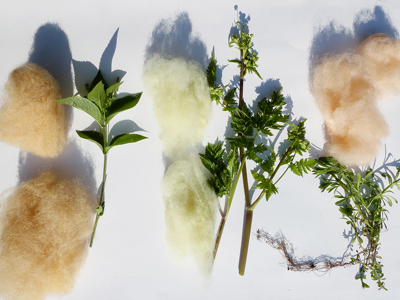
Colours to dye for
30th Mar 2020
This Easter, in the bushcraft arena, I was intending to get you experimenting with wild natural dyes from the various spring plants that are bursting through the forest floor at Wildwood. Unfortunately, with coronavirus lockdown, any plans have had to be shelved and I am obliged to work from home.
As luck would have it, I live in the countryside beside a wood where the same flowers occur that can be found at Wildwood. So far, I have used three of them in my dyeing experiments and I thought I would share my results with you online.
Different substances in different plant parts produce different colours, as you can see. It can be quite amazing and surprising as you boil your plant and see what colour comes out; frequently you never would have guessed! That’s one step – extracting the dye.
Cotton and linen are difficult to dye. Wool is much more user-friendly. I used the fleece from Wildwood’s very own Soay Sheep. Soay are bicoloured – brown and white, though the white turns yellow, and there may be actual yellow in there because some bits never clean up. So far I have use only the white belly wool, but as ancient sheep breeds were often brown or brown and white, the dark wool could be dyed black.
Freshly moulted Soay wool is filthy, naturally greasy stuff and must be washed and rinsed thoroughly before it is ready to take a dye. After, that is has to be soaked in a mordant. This is the chemical that makes the colour stick (from the French word mordre – to bite). Alum – aluminium sulphate – is the one that is most commonly used with wool. A small amount is dissolved in hot water and the wool soaked in water and heated gently then cooled. After rinsing , the wool is then added to the coloured liquid dye, which has been strained of any bits to give a strong even colour, andpoured into a vessel known as the dye bath. I left mine overnight for the results that you see here.
The plants I used and the colours I achieved are as follows (and left to right in the photo). Dog’s Mercury is a poisonous plant beloning to the Spurge family. It is currently carpeting woodland floors everywhere. It produced a rich straw-yellow dye. Cow Parsley has not really reached its flowering timebut the young leaves coloured wool a delicate lemon yellow. The plant on the right is Cleavers or Goosegrass. The leaves are hooked and cling to your clothes and help it scramble over other plants. It is related to a famous dye plant, known as Madder, and like it produces red from the roots. Finding enough and making the colour strong enough was the problem. When I added a little cream of tartar it brightened considerably. Perhaps my mordanting was inadequate because it came out of the dye bath candy-floss pink. Still, it looks good enough to eat.
